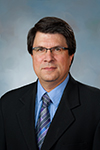Author combines language, programming to create digital pieces
When it comes to his creative process, Nick Montfort considers himself an explorer of language and computing, and his explorations come together to form his completed pieces.
“I have different types of projects, and sometimes I write poems by putting words together one after another using more traditional or unusual techniques but without writing programs,” said Montfort, the final speaker in the fall University of Houston-Victoria/American Book Review Reading Series. “When it comes to my computational poetry, however, there really is no way I could do the writing first. And these projects are usually not driven by any pre-existing concept, theme, or interest in particular subject matter. Rather, I start investigating some aspect of language by working with particular words and structures.”
Montfort is a professor of digital media at Massachusetts Institute of Technology. He will give a presentation about his work and digital poetry at 11 a.m. Dec. 5 in the Alcorn Auditorium inside UHV University West, 3007 N. Ben Wilson St. The event is free and open to the public.
“Nick Montfort offers a unique fusion of poetry with technology that leaves a lasting impression on readers,” said Jeffrey Di Leo, ABR editor and publisher, and dean of the UHV School of Arts & Sciences. “I’m looking forward to his fascinating take on how technology and the written word come together to convey messages and ideas.”
During his presentation, Montfort plans to read from some of his computer-generated poetry, including short pieces from “#!” (pronounced “shebang”), and portions of the book-length poem “The Truelist,” and “Autopia.”
“In all of this work, I’m seeking to use computing to explore language and discover new insights,” he said. “I have many of the same goals as a linguist or a computational linguist – except instead of using the scientific method – instead of being a social scientist – I devise poems, and to do that, I write computer programs. By sharing this work, I hope to explain some about that process.”
Many of Montfort’s computer-generated pieces are available online as well as in book form, while others also are presented as gallery installations. However people come in contact with his work, he hopes they will be able to develop their own thoughts about poetry, language, computing and the various themes and topics into which his work happens to wander.
“I hope people will be able to see that computing is cultural, and that it’s accessible,” Montfort said. “It is not just about numbers but is connected to language as well as other media and different arts.”
The authors for the spring series have been announced. The first speaker will be novelist Jennifer duBois, and she will speak at UHV on Jan. 30.
ABR is a nonprofit, internationally distributed literary journal published six times a year. It began in 1977, moved to UHV in 2006 and has a circulation of about 10,000. The journal specializes in reviews of works published by small presses.
Authors are available after each reading to sign copies of their books. Each author also meets with students and attends a community reception.
For more information about the UHV/ABR Reading Series, call the ABR office at 361-570-4101 or go to www.americanbookreview.org.
The University of Houston-Victoria, located in the heart of the Coastal Bend region since 1973 in Victoria, Texas, offers courses leading to more than 80 academic programs in the schools of Arts & Sciences; Business Administration; and Education, Health Professions & Human Development. UHV provides face-to-face classes at its Victoria campus, as well as an instructional site in Katy, Texas, and online classes that students can take from anywhere. UHV supports the American Association of State Colleges and Universities Opportunities for All initiative to increase awareness about state colleges and universities and the important role they have in providing a high-quality and accessible education to an increasingly diverse student population, as well as contributing to regional and state economic development.
Lauren Hightower-Emerson
361-570-4342






